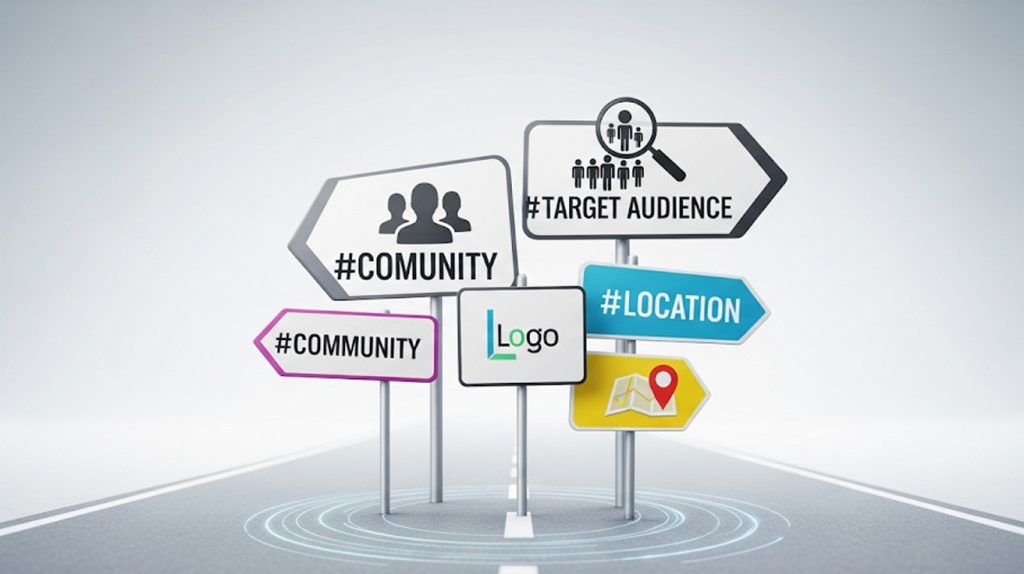Let’s talk about the big hashtag myth. You’ve probably been told that to get more eyes on your content, you need to use all 30 hashtags. So you dutifully paste a giant block of generic tags on every single post. The result? A whole lot of nothing. You’re left with a post that’s full of hashtags but empty of engagement.
The truth is, it’s not about quantity; it’s about quality and a strategic mix.
Think of hashtags as digital road signs. If you’re using a generic sign that just says “Highway,” you’re going to get a lot of random traffic, but none of it will be heading to your specific destination. If you use a sign that says “Highway to the exact community you’re looking for,” you’re going to get the right people, every time.
This guide is your playbook. We’re going to show you a completely new way to use hashtags by breaking down 8 different types that are designed to do one thing: get your content in front of your ideal audience. This isn’t about magical growth hacks; it’s about a smarter, more effective strategy.
Ready to stop guessing and start using hashtags with intention? Let’s dive in.
The Foundational Types
Before you can build a comprehensive hashtag strategy, you need to get the basics right. These first two hashtag types are your foundation. They’re all about giving the algorithm and your audience the clearest possible signals about what your content is and who it’s for.
Type #1: Image-Relevant Hashtags
This is the most basic but most crucial type of hashtag. It’s exactly what it sounds like: a hashtag that describes what is literally in your photo or video. This seems simple, but it’s a game-changer.
Think of it as telling the Instagram algorithm what your content is about. If you post a picture of a coffee, you’d use something like #coffeelover or #baristadaily. This helps the algorithm categorize your content and show it to people who are interested in that specific topic. Don’t skip this step—it’s your first signal for discoverability.

Type #2: Community-Based Hashtags
A community-based hashtag isn’t just about a topic; it’s about a group of people. These hashtags are like digital meeting places where people with shared interests and values gather.
A community-based hashtag for a book lover might be #bookstagram, while a plant enthusiast might use #plantgang. Using these hashtags is a powerful way to connect with a niche audience and get your content in front of people who are already actively engaged in a specific community. It’s a key part of your strategy for building a loyal, engaged following.
The Brand & Niche Types
Once you’ve nailed the foundational hashtags, it’s time to get specific. These next three types are all about building your brand, defining your niche, and attracting the exact audience you want to serve. This is where you move from a broad strategy to a laser-focused approach.
Type #3: Your Own Brand Hashtag
This is the hashtag you create specifically for your business or personal brand. It could be your business name, a clever tagline, or a unique phrase that represents what you do. For example, a bakery might use #SallysSweetShop, while a financial coach might use #WealthWithKip.
The purpose is twofold: it helps you organize all your content under one searchable hashtag, and it encourages your audience to use it when they post about you. This is a powerful way to build a community and track user-generated content.
Type #4: Your Niche Hashtags
Think of your niche as your specialty. These are the hashtags that describe your specific area of expertise. For example, if you’re a fitness coach, instead of the generic #fitness, you’d use something more specific like #athomeworkoutforwomenor #hiitforbeginners.

Niche hashtags help you attract a highly engaged audience that is already interested in your specific topic. They have fewer posts than broad hashtags, which means your content has a better chance of being discovered and getting seen by the right people.
Type #5: What Your Dream Followers Are Searching For
This is a strategy that requires you to put yourself in your audience’s shoes. What are the questions they are asking? What are their problems and desires? The hashtags you use should reflect the exact keywords they are typing into the search bar.
For example, if you’re a social media manager, instead of just #socialmedia, you might use #socialmediatipsforbeginners. This is a direct line to your ideal follower and an incredibly powerful way to find a hungry audience.
The Discovery & Contextual Types
You’ve got your foundational and niche hashtags dialed in. Now, it’s time to expand your reach even further. These final three types are all about getting your content discovered by new audiences and providing critical context that helps the algorithm and users find you.
Type #6: Industry-Related Hashtags
Think of these as your broader, umbrella hashtags. They aren’t as specific as your niche hashtags, but they’re essential for getting your content in front of people who are interested in your general industry.
For example, a financial coach might use #financeliteracy or #personalfinance. These hashtags help you get discovered by people who are interested in your field but haven’t yet found your specific niche.

Type #7: Location
This one is a must-have for local businesses, but it’s also a powerful tool for anyone who wants to attract a local audience. By using location-specific hashtags, you’re telling the algorithm to show your content to people in that area.
For example, a photographer in New York might use #photographernyc, while a baker in London might use #LondonEats. This is one of the easiest ways to attract followers who can become real-life customers.
Type #8: Content-Specific Hashtags
This type of hashtag is all about being a digital librarian. It’s a hashtag that is directly related to the specific topic of your post. If you’re posting a tutorial on making a sourdough starter, you could use #sourdoughstartertutorial.
If you’re sharing a quick tip on using a specific software feature, you might use #canvatips. This hyper-specific approach helps the algorithm categorize your content and shows you as an authority on a particular topic.
Final Word: Your New Hashtag Playbook
You’ve made it to the end. You’ve gotten past the common mistake of using random hashtags and now have a strategic playbook that actually works. You understand that a powerful hashtag strategy isn’t about using all 30 tags; it’s about using a strategic mix to get your content in front of the right people.
You know the distinct roles each type of hashtag plays: the foundational types give the algorithm a clear signal, the brand and niche types help you attract your ideal audience, and the discovery and contextual types get your content found by new eyes. This isn’t just about getting more reach; it’s about getting more relevant reach.
This simple mindset shift is the key to your growth. By auditing your current hashtag strategy and implementing a mix of the 8 types, you’re building a powerful system for attracting a loyal, engaged community that will help you accelerate your Instagram growth.
Now that you have the playbook, your challenge is to put it to work. Audit your last few posts and see which hashtag types you’ve been missing. What’s the one type you’re going to try first?

